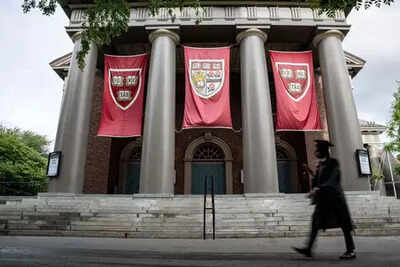ARTICLE AD BOX

Why Judge Burroughs ruled against the Trump administration’s DEI-linked funding freeze. (IANS Photo)
In 2025, Washington tried to redraw how it polices American higher education. A multi-agency push to tackle campus antisemitism quickly morphed into something larger: Using federal research cheques as leverage to force universities to change how they are governed, staffed, and taught.
Across the spring, elite campuses from Columbia to MIT were warned that future grants could hinge on sweeping conditions, testing the line between lawful civil-rights enforcement and political control of academic life. Harvard became the proving ground. By 31 March, the elite institute was told that $8.7 billion in federal support sat ‘under review’. What followed wasn’t oversight so much as an ultimatum. On 3rd April came an official notice with preconditions—remake governance, reorder staffing, run viewpoint “audits,” shutter DEI programmes—and, in a same-day email “menu,” an astonishing proposal: A “senior secured 1st lien” on Harvard’s assets.
Eight days later, the demands hardened again: Hire and admit a “critical mass” to rebalance ideas and submit to prolonged federal oversight. Harvard declined on 14th April and within hours, the Administration hit the labs with a $2.2 billion freeze. Through May, termination letters marched across the alphabet soup—NIH, USDA, Commerce, Defence, Energy, HUD, NSF. By June, Harvard was in federal court in Boston, suing the agencies behind the freeze; proceedings moved on an expedited docket.
Finally, on 3rd September, Judge Allison D. Burroughs restored the money and drew a constitutional line: Science funding is not a lever to re-engineer a university’s inner life. Well, Judge Burroughs didn’t side with Harvard because she’s an “Obama appointed Judge”, as Donald Trump would have us believe. Way before the judgement, he took to Truth Social and wrote, “The Harvard case was just tried in Massachusetts before an Obama appointed Judge. She is a TOTAL DISASTER, which I say even before hearing her Ruling.” He sharpened it further with a populist flourish, “How did this Trump-hating Judge get these cases? That line is shrewd politics: It turns a dry fight over grant law into a morality play about elites and a ‘rigged’ bench.
But courts do not score rallies; they read records. Here is exactly why Burroughs sided with Harvard, not Trump.Retaliation, not regulationHere’s the core point. On the morning of 14th April, Harvard said no to the government’s demands. That same day, Washington froze about $2.2 billion. In May, agencies began sending termination letters. The court read that sequence as punishment for refusal, not neutral civil-rights enforcement.
Under the First Amendment, the government can’t pull money because a university declines to adopt its preferred speech, policies, or internal power map.
Burroughs said that is what happened here—retaliation, not regulation.The unconstitutional-conditions problemEven if motive didn’t matter, the method did. The government may attach narrow, lawful conditions to research grants (think lab safety or accounting rules).
It may not demand viewpoint or governance concessions that have little to do with curing cancer or building a quantum chip. The April letters did exactly that: “viewpoint” audits department by department, hiring and admissions to reach a political “critical mass,” restructuring faculty influence, scrapping DEI as a litmus.
That is using science money to coerce speech and redesign governance. The Constitution doesn’t allow it.Shortcuts under Title VI and the APAThere’s also a process—and it isn’t optional. Title VI sets the choreography before cutting funds: (1) formal notice, (2) a real chance for voluntary compliance, (3) a hearing and on-the-record findings, and (4) a narrow, programme-specific remedy, plus notice to Congress. The government skipped those steps before announcing freezes and terminations. Under the Administrative Procedure Act, whiplash decisions, shifting justifications and thin evidence are arbitrary and capricious.
Translation: You must prove a violation and follow the rulebook. You can’t punish first and justify later.Bottom LineIn the end, the Harvard fight is less about Ivy League privilege and more about how the government wields power. Judge Burroughs did not excuse campus bigotry; she insisted that if Washington wants to police discrimination, it must prove violations, follow process and tailor remedies to the programme at issue.
That standard protects the research commons from political whiplash and tells universities to clean their own house with facts, not theatre.
An appeal will come from the Trump administration, rhetoric will rise, but the centre line is now drawn: Grants fund science, they do not buy control of a campus. Fight bigotry with law, not leverage; regulate misconduct, do not re-engineer universities.



.png)
.png)
.png)
















 1 day ago
4
1 day ago
4








 English (US) ·
English (US) ·